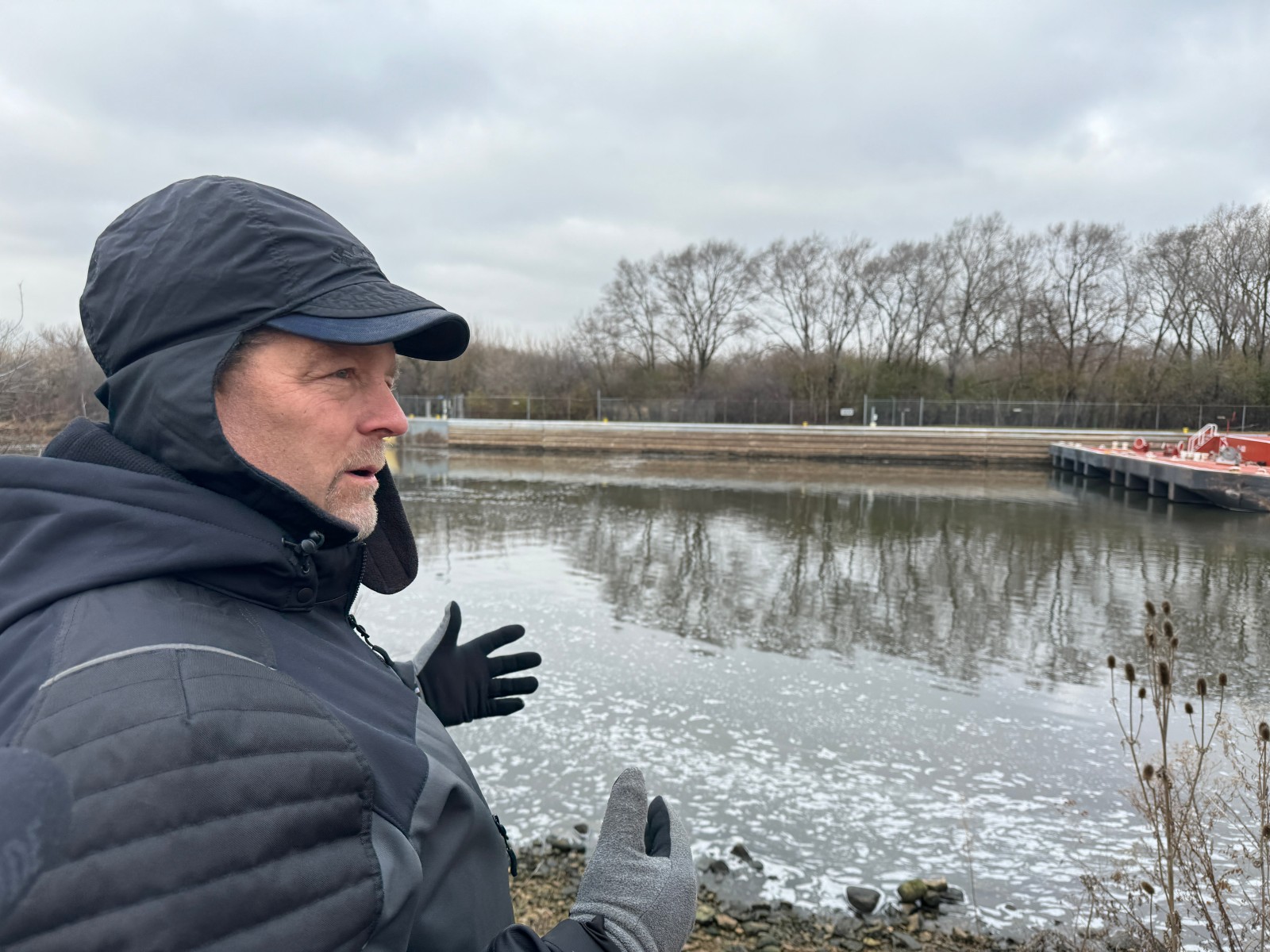
This coverage is made possible through a partnership between WBEZ and Grist, a nonprofit, independent media organization dedicated to telling stories of climate solutions and a just future. Sign up for WBEZ newsletters to get local news you can trust.
Scott Whitney, of the Army Corps of Engineers, stands on a peninsula of the Des Plaines River carved out nearly a century ago to make way for the Brandon Road Lock and Dam in Joliet.
As a chief of project management with the Army Corps, Whitney helps to make sure the invasive carp that took over parts of the Illinois River in the 1990s don’t make it to the other side. Soon the Army Corps could set in motion its nearly decade-long plan for this site and create a barrier to those nuisance fish.
To prevent the prolific fish from spilling out of Illinois’ waterways and into Lake Michigan and beyond, the Army Corps is planning to build a $1.416 billion high-tech suite of barricades to deter the fish from moving upstream. The Brandon Road Interbasin Project could take anywhere from six to eight years at a minimum to complete once construction. The Army Corps and state department of natural resources are still working to finalize a partnership agreement.
“One technology by itself is only so good, but four or five technologies together is going to give us what we need,” said Whitney of the megaproject that will include an electric barrier, a bubble wall, sound blasts and a flushing lock.
Invasive carp is shorthand for a family of giant fish that can out-eat, out-grow and out-reproduce native fish. In parts of the Illinois river, researchers say there’s more carp than anywhere else on the planet. The furthest upstream populations of the carp are approximately 14 miles downstream. But Whitney and other scientists worry that there’s increasingly an opportunity for the carp to make it through and disrupt the food web inside the Great Lakes. Carp could decimate the entire recreational and commercial fishing industry that has sprung up around the lakes that’s valued at $7 billion annually.
“The Great Lakes fisheries resources is a phenomenally rich resource that’s billions of dollars a year,” Whitney said. “Fish that come in and feed at the bottom of the food chain, they affect the entire ecosystem.”
Whitney said on any given day, about 15 barges carrying petroleum products pass through here. The river has been a major economic highway since Illinois decided to break open the Great Lakes to the Mississippi River beginning in the 1800s with a system of canals.
Joining the two watersheds turned Illinois into a major connector for a trade route from the Gulf of Mexico out past Canada. Every year, hundreds of tons of goods and commodities worth billions of dollars flow through the Chicago Sanitary and Ship Canal.
There is a spot near the confluence of the Illinois and Des Plaines rivers that the fish simply won’t cross. Scientists have theorized that Chicago’s waterway pollution has kept the carp in check for years.
“If you go and sample fish from that leading edge and compare those fish to the downstream edge, we see higher indices of stress in those animals living at the upstream edge,” said Cory Suski, a professor of aquatic resources at the University of Illinois Urbana-Champaign.
Suski found that fish closer to Chicago exhibited signs of increased exposure to contaminants than their downstream counterparts. Most recently, Suski and collaborators tested how young silver carp performed in water from the Chicago Area Waterway System (CAWS). They found that the carp’s behavior was off and just inhabiting the upstream water required more energy than usual.
But the water quality of the CAWS is better than it’s ever been. Although 70% of the water in the CAWS comes from wastewater treatment facilities, fish species are beginning to thrive there. And that’s a concern.
“There’s a lot of work going on to improve the water quality.” Suski said. “And if something does change, we could maybe start to see a change in the movement of the carp.”
There’s already more than 180 invasive species in the Great Lakes, according to Molly Flanagan. She’s with the Alliance for the Great Lakes, an advocacy organization working to protect the interconnected freshwater ecosystem.
Flanagan says the carp could turn Lake Michigan into a pathway to spread.
“The concern is invasive carp get into the lakes via the Chicago waterway,” Flanagan said. “And then they move into rivers and streams in the Great Lakes region.”
Whitney, of the Army Corps, said that’s why construction on the megaproject is necessary.
“Rarely do we have opportunities like this, to really stop something in its tracks, because typically, once they’re here, they’re here to stay,” Whitney said.
Juanpablo Ramirez-Franco covers climate change and the environment for WBEZ and Grist. Follow him on X at @__juanpab.
Catch more news at Great Lakes Now:
Warmer winters mean less ice on Lake Michigan – hurting lake trout and whitefish
Great Lakes policy advocate calls out Illinois for intransigence on invasive carp solution
Featured image: Scott Whitney, of the Army Corps of Engineers, is on the banks of Des Plaines River. This area will be the first stage of construction on the Brandon Road Interbasin Project. Juanpablo Ramirez-Franco / WBEZ




